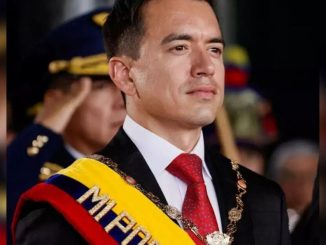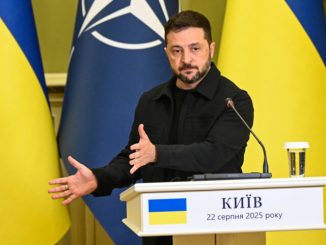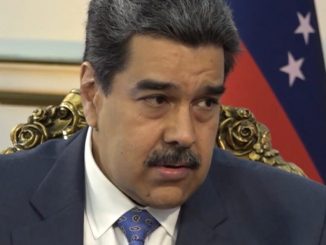
| Published August 20, 2025
Tensions between the United States and Venezuela have reached a dramatic peak as Venezuelan President Nicolás Maduro announced the activation of 4.5 million civilian militia members across the country. This move comes in response to what Maduro calls “outlandish threats” from the United States, following Washington’s decision to double the bounty on his arrest to $50 million, citing alleged drug trafficking links to the infamous Cartel of the Suns.
U.S. Military Presence Near Venezuela
The United States has significantly increased its naval presence near Venezuelan waters, deploying three Aegis-equipped guided-missile destroyers: the USS Gravely, USS Jason Dunham, and USS Sampson. These ships are capable of long-range missile strikes, advanced radar surveillance, and air defense operations, making them a formidable deterrent in the region.
This deployment comes amid heightened tensions following Washington’s decision to double the bounty on President Maduro to $50 million, citing his alleged links to drug trafficking and the notorious Cartel of the Suns. The U.S. government frames the military presence as part of a broader counter-narcotics and anti-terrorism strategy, targeting organized crime networks that operate across Latin America.
Analysts note that this kind of naval positioning serves multiple purposes:
-
Deterrence – Signaling U.S. resolve to protect its interests and discourage further aggressive actions by the Venezuelan government.
-
Rapid Response Capability – The destroyers’ advanced sensors and missile systems provide the U.S. with the ability to respond quickly to incidents at sea or along Venezuela’s coastline.
-
Strategic Messaging – The deployment sends a clear signal to both domestic and international audiences that the U.S. is closely monitoring Venezuela and prepared to act if necessary.
However, officials stress that the current operations are defensive rather than offensive, and there is no public indication of imminent plans for a direct military strike. Still, the presence of U.S. warships in close proximity to Venezuelan waters raises the stakes and contributes to regional uncertainty, particularly for neighboring countries like Colombia and Brazil, which are closely monitoring the situation.
Maduro’s Nationalist Messaging
President Nicolás Maduro’s mobilization of 4.5 million civilian militia members is as much a political maneuver as it is a military one. By arming rural populations with rifles and implementing a “special national defense plan,” Maduro is sending a message of resilience and sovereignty—portraying himself as the protector of Venezuela against perceived foreign aggression.
This messaging serves several purposes:
-
Domestic Consolidation of Power
-
By emphasizing the threat from the United States, Maduro strengthens his narrative of external enemies plotting against Venezuela, which can rally support among his political base.
-
The mobilization also appeals to rural and working-class Venezuelans, positioning them as guardians of the nation and increasing loyalty to his government.
-
-
Distraction from Economic Challenges
-
Venezuela continues to face hyperinflation, fuel shortages, and economic instability. Highlighting foreign threats shifts attention away from domestic problems and frames the government’s focus as defending the nation rather than managing its internal crises.
-
-
Nationalist Propaganda and Identity
-
Maduro’s rhetoric reinforces the idea of Venezuelan sovereignty as non-negotiable, creating a sense of unity against external pressures.
-
The narrative of “ordinary citizens as defenders” taps into national pride and historical memory of resistance, portraying Venezuela as a nation capable of defending itself against stronger powers.
-
-
Signaling to the International Community
-
By showcasing a massive civilian mobilization, Maduro signals to other countries that Venezuela is not an easy target.
-
It serves as a warning to international actors contemplating sanctions, interventions, or other aggressive moves.
-
Despite the dramatic scale, experts note that the militia is largely symbolic in terms of conventional military capability. Its primary function is political: consolidating Maduro’s power internally and positioning Venezuela as defiant on the global stage.
In essence, the militia mobilization is as much about image and perception as it is about defense—casting Maduro as a leader willing to fight for sovereignty while attempting to unify the nation under a nationalist banner.
 Implications
Implications
1. Regional Security Concerns
-
Mobilizing 4.5 million civilian militia members significantly increases Venezuela’s internal military capability.
-
Neighboring countries (Colombia, Brazil, Guyana) may perceive a heightened risk of spillover violence or border conflicts.
-
U.S. naval presence near Venezuela signals a show of force, potentially deterring or escalating military incidents in international waters.
2. Domestic Political Messaging
-
Maduro’s call to arms and distribution of rifles serves as a nationalist rallying tool, strengthening his position internally by portraying himself as the defender against foreign aggression.
-
It could also distract from Venezuela’s economic crises and high inflation by emphasizing external threats.
3. U.S. Policy and Counter-Narcotics Strategy
-
Deployment of Aegis-guided missile destroyers is framed as targeting drug cartels, particularly the “Cartel of the Suns.”
-
This move demonstrates the U.S. willingness to combine military pressure with criminal justice strategies, including a $50 million bounty for Maduro.
-
However, heavy-handed U.S. measures could push Venezuela closer to alliances with non-Western powers like China or Russia.
4. International Relations
-
Tensions may affect global oil markets, given Venezuela’s role as a crude oil producer.
-
Other countries may have to take sides diplomatically, balancing sanctions, trade, and security concerns.
-
Escalation risks could limit foreign investment or humanitarian aid in Venezuela.
5. Risk of Miscalculation
-
While analysts see a full-scale war as unlikely, the large-scale militia mobilization and U.S. naval deployment increase the risk of accidental clashes.
-
Even minor incidents could rapidly escalate tensions, prompting broader military or economic responses.
 Overall Takeaway:
Overall Takeaway:
While headlines about “4.5 million troops” and U.S. destroyers near Venezuelan waters are alarming, the current standoff is largely strategic posturing rather than preparation for full-scale war. Maduro’s militia mobilization serves as a domestic political tool and a warning to external actors, while the U.S. naval presence underscores its counter-narcotics and geopolitical signaling.
The broader implication is that both nations are testing each other’s resolve, with risks concentrated in regional security, diplomatic relations, and potential miscalculations. For now, tensions remain high, but a direct military conflict appears unlikely.
The situation will need careful monitoring, as even symbolic moves could have outsized effects on neighboring countries, oil markets, and international diplomacy.





Be the first to comment